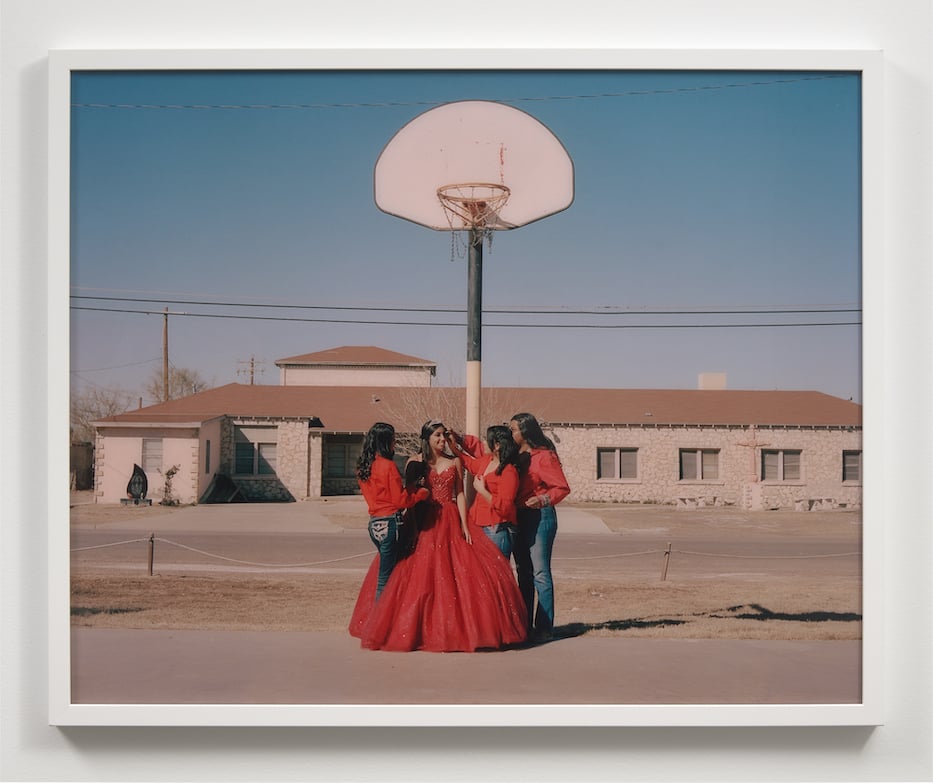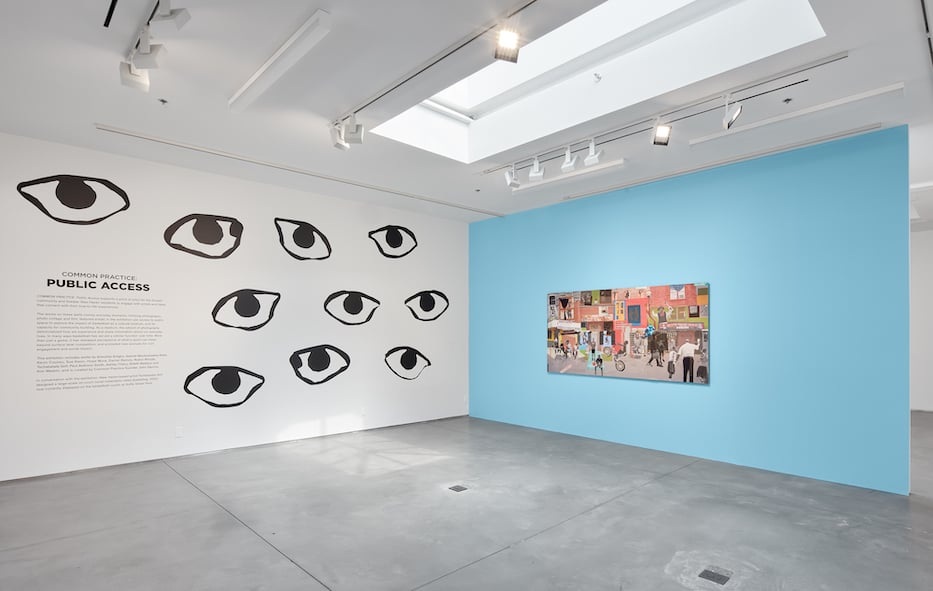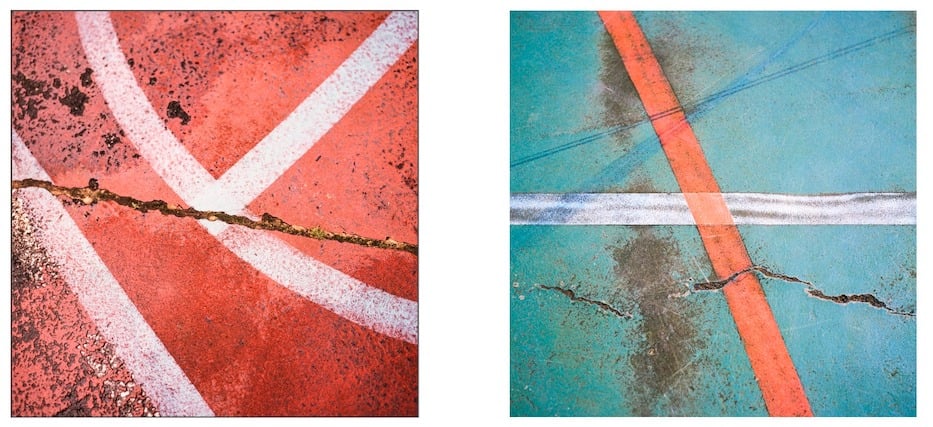
Dixwell | NXTHVN | Arts & Culture | Arts & Anti-racism | Basketball

.jpg?width=933&height=783&name=Hope%20Mora(1).jpg)
A swarm of oversized black and white eyeballs by New Haven-based artist Tschabalala Self scatter around the room. They reappear as reflections in the glass frames of other works, inflecting the space with the feeling of voyeurism. The same forms repeat in Eyeballing, two public basketball courts Self designed in nearby Goffe Street Park. This public art project is a collaboration between the artist, NXTHVN, and Common Practice, an initiative that combines basketball and art to foster civic engagement within specific communities.
COMMON PRACTICE: Public Access, the group exhibition that houses Self’s eyes, focuses on New Haven’s Dixwell neighborhood, where NXTHVN and the courts are located. The show’s curator, John Dennis—Common Practice’s founder as well as NXTHVN’s Creative Director—hopes that both the show, on view through Sept. 3, and the revamped courts inspire deeper connections between the Henry Street art space and its neighbors.
Basketball is a running theme in the show. The photographs and mixed media works in the exhibition occur outside, many in the heat of summer. The artists—Anwulika Anigbo, Kevin Couliau, Sue Kwon, Hope Mora, Jeanne Moutoussamy-Ashe, Daniel Ramos, Robin Rhode, Tschabalala Self, Paul Anthony Smith, Ashley Tillery, SHAN Wallace, and Kim Weston—engage common spaces such as basketball courts and parks, drawing a connection between the public art project unveiled on June 10 and the group exhibition.
.jpg?width=933&height=1459&name=SHAN%20Wallace(1).jpg)
On a sky blue wall, a large collage by SHAN Wallace, the inaugural recipient of the Common Practice Assist Grant, combines fragments of the Dixwell neighborhood from color and black-and-white reproductions. New Haven Block Party hints at the history of the neighborhood, which once boasted a thriving jazz scene and club where Miles Davis played. Her collage includes signage from local businesses such as “Get ‘Em Boy Boxing” and “Eddy’s Food Centre,” alongside a lively cast of people.
A young boy on a bike pops a wheelie, another holds a basketball. Behind a child holding a camera, a viewer can peer into the windows of NXTHVN, where the wall text for the gallery’s previous exhibition “Not for Sale” is legible inside. A man playing trumpet carries several bright blue balloons—a nod to Hank Willis Thomas’s the truth is i am you, yet another NXTHVN exhibition that prompted visitors to write messages on silver Mylar balloons.
In Wallace's piece, nearly all the faces that engage the viewer directly have been altered in some way—mismatched eyes, enlarged pink lips, among other aberrations—while the heads seen from behind or in profile are unaltered. These facial interruptions underscore the idea of the voyeur: the most visible are the most distorted. In this neighborhood scene, the effects of surveillance counterbalance moments of joy and celebration.
.jpg?width=933&height=1027&name=Kim%20Weston(1).jpg)
Across the room, a pair of photographs by Kim Weston convey the coolness of a fading summer sun and play on the idea of extended looking. Hangtime and Fireball depict the same scene—a basketball court and players—but their bodies have morphed into gossamer outlines. In Fireball, three people blur together, solidifying into one mass and converging into separate dancers simultaneously. The artist’s long exposure technique traces their movement through time, infusing an ordinary space with a transcendental aura.
Here, basketball tumbles into the sublime, a sharp departure from nearby shots of everyday moments by Ashely Tillery. Photographs by Jeanne Moutoussamy-Ashe and Sue Kwon also capture mundane experiences—people standing, waiting, and watching other people on basketball courts.
Other works demonstrate how a basketball court can be used to mark an occasion. In Hope Mora’s inkjet print, Hannah’s Quince, a hoop hovers over the heads of a huddled group of young women. The central figure wears a red quinceañera dress, her large tulle skirt engulfs the legs of the women primping her. .jpg?width=933&height=430&name=Kevin%20Couliau(1).jpg)

Paul Anthony Smith’s Dream Deferred #49 presents a surprising optical experience, perhaps with a subtle message. In this work, Smith added impasto leaves and flowers over an inkjet print of a chainlink fence. The metal fence is blurred, its edges obscured, while the dark shadow of the fence has been spray painted over the heavily textured foliage.
Curiously, the shadow hovers over the fence, too—a move that makes the fence and its shadow start to feel like a cage. The scale of the composition feels roughly akin to a person, with the liveliest parts of this scene out of reach.
The aim of COMMON PRACTICE is to create an accessible show, an opportunity for Dixwell residents “to engage with artists and ideas that connect with their true-to-life experiences,” according to the exhibition wall text.
.jpg?width=933&height=771&name=Sue%20Kwon(2).jpg)
Reading between these lines, a viewer might wonder how other shows have been received within the immediate community. From outside eyes, it’s “a neighborhood buffeted by need in the shadow of Yale,” as described in a New York Times profile of the arts incubator’s co-founder Titus Kaphar.
From a New Haven perspective, it’s a new and not yet completely welcome development in a neighborhood steeped in Black history, including two of the oldest Black churches in New England and a beloved community center that only recently reopened its doors.
Co-founders Kaphar and Jason Price have previously acknowledged that the surrounding community has greeted their agenda with some suspicion. NXTHVN doesn’t employ many Dixwell residents. Self, in preparation for the courts’ installation, told the Arts Paper multiple times through her assistant that she was too busy for a five-minute interview about the project.
Self’s eyes, meanwhile—on the Goffe Street courts and within the gallery—hint at the idea of being watched. NXTHVN seems to understand how many are waiting to see how this space will impact its environment—both Dixwell and Greater New Haven—in the long run.
In the present, this show also seeks to position photography and basketball as cultural mediums that are available to all. Most meaningfully, this effort extends outside the sleek gallery and into the public realm—back on to the basketball courts referenced throughout the show.
COMMON PRACTICE: Public Access runs through September 3, 2023, at NXTHVN, 169 Henry St. in New Haven’s Dixwell neighborhood.

